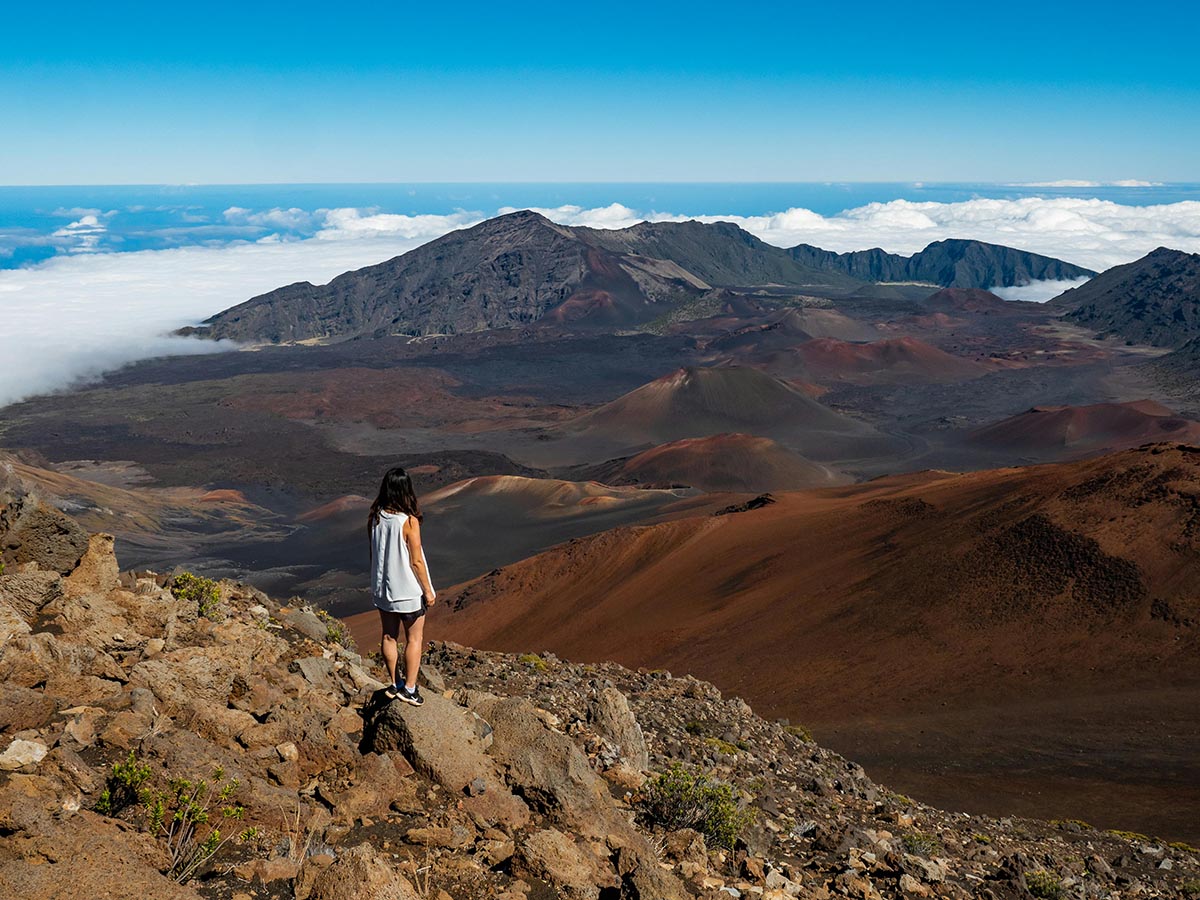
Visiting Hawaii had always been a dream of mine. The lure of its beautiful beaches, lush landscapes, and rich culture was irresistible. When I finally booked my trip, I had no idea that beyond the natural beauty, this getaway would teach me valuable lessons in minimalism. From the simplicity of island life to the essentials-only mindset required for travel, my Hawaiian adventure transformed my outlook on life. I will do my best to share some storage and minimalism lessons you can learn during a Hawaiian getaway.
Arrival in Paradise
Stepping off the plane in Honolulu, I was immediately greeted by the warm, tropical air. The hustle and bustle of the airport quickly gave way to the laid-back vibe of the island. My first stop was Waikiki Beach, where I stayed in a modest hotel with an incredible ocean view. This initial taste of minimalism came in the form of my accommodations. Instead of opting for a luxurious resort, I chose a simple room that provided just what I needed: a comfortable bed, a bathroom, and a breathtaking view.
This decision set the tone for the rest of my trip. It was a reminder that I didn’t need extravagant surroundings to enjoy myself. In fact, the simplicity allowed me to focus more on the experiences and less on the material aspects of my stay.
Embracing the Essentials
Hawaii’s natural beauty is its greatest asset, and I spent most of my days exploring the outdoors. I visited the stunning Hanauma Bay for snorkeling, hiked up Diamond Head for panoramic views, and took a road trip along the North Shore. Each activity reinforced the idea that true enjoyment comes from experiences rather than possessions.
Packing light became an essential lesson in minimalism on my Hawaiian getaway. I realized that I only needed a few pieces of clothing, some basic toiletries, and my camera. This pared-down packing list made travel easier and highlighted how much unnecessary clutter I typically carried in my daily life.
Living with Less
The Hawaiian lifestyle emphasizes living with less and appreciating more. Locals often favored practical, multi-purpose items over single-use gadgets and trinkets. This was evident in everything from their homes to their wardrobes. Inspired by this approach, I decided to adopt a similar mindset.
I visited several local markets where artisans sold handmade goods during my stay. These markets were a testament to the island’s emphasis on quality over quantity. Each item was crafted with care and designed to serve a purpose. I bought a few souvenirs, each carefully chosen for its utility and beauty. These items held more meaning than any mass-produced keepsake ever could.
Mindful Consumption
One of the most impactful minimalism lessons you can learn during a Hawaiian getaway is the importance of mindful consumption. In Hawaii, there is a strong emphasis on sustainability and respecting the environment. This is evident in the local cuisine, which heavily features fresh, locally sourced ingredients. I enjoyed meals at farm-to-table restaurants where the focus was on quality, not quantity.
Eating this way made me more conscious of my consumption habits. I started to appreciate the value of high-quality, nutritious food over processed, convenience items. This shift in mindset extended beyond food to other areas of my life, including clothing and personal care products. I began to prioritize items that were sustainably produced and designed to last.
Disconnecting to Reconnect
One of the unexpected benefits of my Hawaiian getaway was the opportunity to disconnect from technology. With limited Wi-Fi and an abundance of natural beauty, I found myself spending more time outdoors and less time on my phone. This break from constant connectivity was refreshing and allowed me to fully immerse myself in my surroundings.
Without the distractions of social media and emails, I was able to be present in the moment. I spent my days exploring hidden beaches, hiking through rainforests, and watching sunsets. This slower pace of life reminded me of the importance of disconnecting to reconnect with myself and the world around me.
Connecting with Others
Disconnecting also helped me connect with people who loved Hawaii just as much as I did. During my trip, I met several people who had even made the leap of moving here for good, inspired by the minimalist way of life, including a couple who had recently completed the move from Florida to Hawaii. They shared their experience of hiring interstate movers to transport and store their minimal possessions, which helped ease the transition and allowed them to focus on settling into their new lives. Hearing their stories further inspired me to adopt a minimalist mindset and appreciate the beauty of a simplified life.
Adopting a Minimalist Mindset
Returning home, I brought with me a newfound appreciation for minimalism. The lessons I learned during my Hawaiian getaway were invaluable. I realized that living with less allowed me to focus on what truly mattered: meaningful experiences, relationships, and personal growth.
I began to declutter my home, getting rid of items that no longer served a purpose. I adopted a more intentional approach to shopping, focusing on quality over quantity. This shift reduced physical clutter and created a sense of mental clarity.
Sustainable Living
Hawaii’s emphasis on sustainability had a lasting impact on me. I became more mindful of my environmental footprint and sought ways to live more sustainably. I started using reusable bags, bottles, and containers, reducing my reliance on single-use plastics. I also made a conscious effort to support local businesses and artisans, knowing that my choices could make a difference.
The island’s approach to living in harmony with nature inspired me to make changes in my daily life. I started a small garden, began composting, and made more environmentally friendly choices in my home. These steps, though small, contributed to a larger goal of living more sustainably and consciously.
The Role of Storage in Minimalism
Another significant lesson from my Hawaiian adventure was the importance of efficient storage solutions. Staying in smaller accommodations forced me to think creatively about how to organize my belongings. Limited space meant that I had to be selective about what I brought with me and how I stored it. This experience underscored the value of having a streamlined storage system at home.
Efficient storage is a cornerstone of minimalism. It encourages keeping only what is necessary and useful while also ensuring that everything has its place. This approach not only reduces clutter but also makes it easier to maintain a tidy, organized space. Inspired by my time in Hawaii, I revamped my storage solutions at home, focusing on functionality and simplicity.
Final Reflections
My Hawaiian getaway was more than just a vacation; it was a journey towards a simpler, more intentional way of living. There are many minimalism lessons you can learn during a Hawaiian getaway, and the ones I learned during my time on the islands have stayed with me and influenced my lifestyle and mindset. I realized that true happiness and fulfillment come not from material possessions but from meaningful experiences and a mindful approach to life.
About the author:
Marlie Parsons is a freelance journalist and travel writer who resides in the Vancouver, British Columbia area.
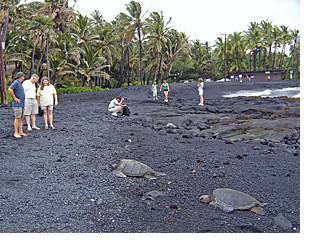
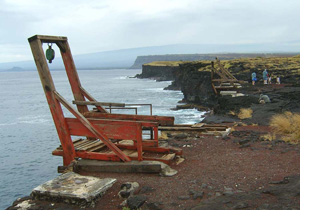 Near these wooden platforms, azure-blue seawaters surge up the sides of a puka in the lava…and gently recede. With meticulous timing, divers leap into this deep hole, ride through the lava tube into open ocean…climbing back up the cliff on rusty ladders…
Near these wooden platforms, azure-blue seawaters surge up the sides of a puka in the lava…and gently recede. With meticulous timing, divers leap into this deep hole, ride through the lava tube into open ocean…climbing back up the cliff on rusty ladders…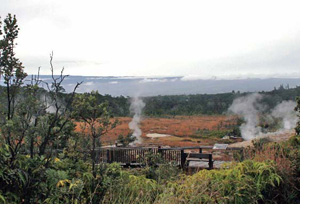 Billowing volcanic gasses seep from the ground, enshrouding treeless landscapes and depositing acid-yellow crystals on surrounding rocks. Returning atop the crater’s rim, countless steamy vents cloak purple-pink orchids and vegetation with a swirling, ghostly mystique.
Billowing volcanic gasses seep from the ground, enshrouding treeless landscapes and depositing acid-yellow crystals on surrounding rocks. Returning atop the crater’s rim, countless steamy vents cloak purple-pink orchids and vegetation with a swirling, ghostly mystique.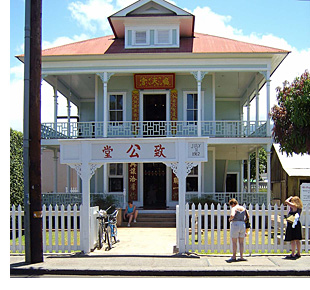
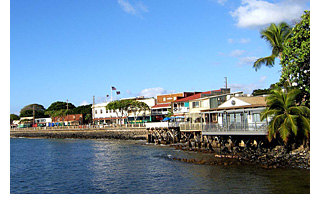 Pointing northward to Kahekili Beach Park, she continued, “Warriors trained there…and Hawaiians launched their koa-wood canoes to visit Lanai.” Also nicknamed Airport Beach, old airstrip fragments remain off in the bushes. “The terminal’s Windsock Bar was well-known by travelers between 1960 and 1987 for great Bloody Marys,” Keli’i winked.
Pointing northward to Kahekili Beach Park, she continued, “Warriors trained there…and Hawaiians launched their koa-wood canoes to visit Lanai.” Also nicknamed Airport Beach, old airstrip fragments remain off in the bushes. “The terminal’s Windsock Bar was well-known by travelers between 1960 and 1987 for great Bloody Marys,” Keli’i winked.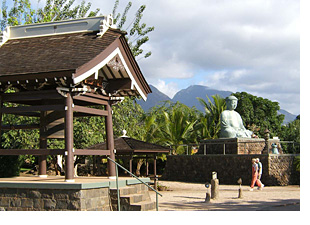 Back at Banyan Park’s southwest corner, fort remnants from 1831 endure, originally built after raucous sailors lobbed cannonballs into town, disputing with missionaries over Hawaiian women visiting their ships. Demolished twenty years later, hand-cut coral blocks from its 20-foot-high walls built the jail standing at Prison and Waine’e Streets.
Back at Banyan Park’s southwest corner, fort remnants from 1831 endure, originally built after raucous sailors lobbed cannonballs into town, disputing with missionaries over Hawaiian women visiting their ships. Demolished twenty years later, hand-cut coral blocks from its 20-foot-high walls built the jail standing at Prison and Waine’e Streets.